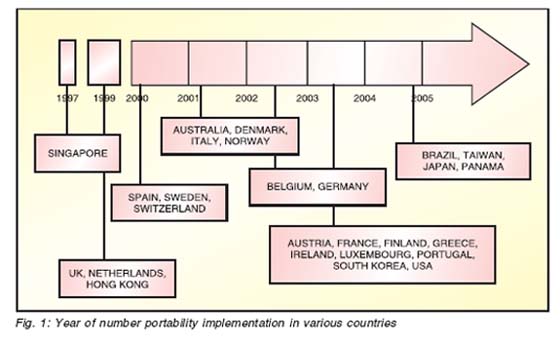Apr 25, 2024
Apr 25, 2024
 The Concept:
The Concept:
Number portability means a user or subscriber can retain his / her number while switching operators, services or locations and without any compromise on quality, reliability and operational convenience.
Let’s understand it with an example. Say that a customer wants to shift from Idea to Airtel service provider or operator.
Case1: Absence of number portability
The subscriber has to give up the Idea number 9850912345 and has to adopt new phone number 9890354321 – from Airtel. The subscriber’s inability to keep his/her telephone number while switching between operators is one significant obstacle to competition in telecom industry.
Problems faced:
Case 2: With the presence of number portability
The subscriber owns the phone number (i.e. 9850912345) and retains the same phone number while switching between operators. It leaves consumers free to pursue better service or lower rates with a new operator.
The main idea behind it is to increase the level of competition between service providers, rewarding service providers with the best customer service, network coverage, and service quality and which leads to customer service improvement.
Number Portability: Definition and Types
Mobile Number Portability (MNP), and synonymously Wireless Number Portability, refers to the ability to change mobile service providers and keep the same phone number.
Local Number Portability (LNP), also referred to as Fixed Number Portability, typically refers to changing fixed (wire line) service providers and keeping the same dial number. Local denotes that the subscriber has not moved or changed locations, but rather has a new service provider while remaining at the same location.
Wireless Local Number Portability (WLNP) is a somewhat more generic term, and refers to switching between mobile and fixed service providers, as well as fixed-to-fixed and mobile-to-mobile ports.
Number Portability: Terminology
Consider below scenario, in which Mobile Number Portability is implemented and subscriber is switching from Idea to Airtel operator.
Idea Airtel
Port Out Port In
Old service provider New service provider
Donor Receiver
a. Port In
- Win new customer.
- Win back customer, which were ported out to other operator.
- In above diagram, customer is ported “in” to Airtel.
b. Port Out
- Loose existing customer.
- In above diagram, customer is ported “out” from Idea.
c. Donor Network
Initial network where number was located before porting. Idea is donor network in the example above.
d. Recipient Network
Final network where number is located after porting. Airtel is recipient network in the example above.
e. Originating Network
Network where the calling party is connected.
f. Database
Database of ported numbers with relevant routing numbers.
Number Portability: Background
The following graph shows a relative timeline of Number Portability implementation in various countries. Mobile number portability has already been implemented in places like Singapore, UK, Netherlands, Hong Kong, Australia, Germany, France, USA, and Japan.

Number Portability: Benefits
Number portability is a fundamental prerequisite for competition in a telecommunications market. Without this facility users are locked into their existing suppliers and can change operator only with considerable disruption and expense.
While it is recognized that the mobile market is already competitive, a telecom market cannot be considered truly competitive until users have the right to change operators at minimal cost and with minimal inconvenience.
Many operators claim that Mobile Number Portability (MNP) is unnecessary and is an unwarranted expense, using assertions that the sector is highly competitive. Some mobile operators have gone to considerable trouble to make MNP difficult and have discouraged customers from exercising this right.
However, we should strongly encourage governments and Regulatory Agencies to recognize that Mobile Number Portability (MNP) is an essential part of the competitive framework and should be made legally binding on all operators and service providers.
Consumer Benefits
At the individual subscriber level, the biggest impact to changing phone numbers is not to the subscriber, but to those individuals in the subscriber’s circle of friends, family and acquaintances. All unnecessary burdens of updating written address books, changing programmed contacts lists, remembering the new number are removed.
Market Benefits
Operators become even more focused on subscribers, rather than continuing price wars, they tend to start consumer loyalty programs, improve customer service, reduce hold times, increase outbound calling programs, focus on renewal incentives, work to improve network coverage, roll-out additional differentiated services such as Wi-Fi agreements, push-to-talk service, 3G, and other customer-pleasing new functionality.
Regulatory Benefits
The infrastructure developed for MNP has been used to solve other problems in some countries. Where directory number resources (i.e. number ranges) were being exhausted, the infrastructure to make NP possible was also used to allow numbering plan administrators to assign numbers in a more efficient manner (to assign a block of 1000 numbers to an operator rather than a block of 10,000 numbers).
Operator Benefits
On the surface, it would seem that NP is a financial and implementation burden to operators; and increased competition, lower prices and hence lower margins. It can be argued to be more cost prohibitive and bad for consumers since the cost of implementing has to be paid for by subscribers, and could ultimately put the operator out of business.
However, some operators have used the mandate for NP as an opportunity to gain market share and target subscribers as well as multi-line business customers. As with any market where a barrier to competition is lifted, some of the free market agents will gain, and some will lose. In the U.S., operators who took a proactive stance in preparing for NP were able to increase net additions in the face of increased competition. This was through a combination of customer service improvements, network improvements, targeted advertising, focus on fixed- to-mobile porting (also known as displacement), and to a lesser degree, more competitive rate plans.
Conclusion
The MNP process is relatively new to India but holds lots of scope. With the revolution of mobile telephony sector in India, the subscriber base has grown by leaps and bounds over the past decade. It can also lead to lots of errors like customer dissatisfaction, misalignment between the old and new service operator, loss of revenue and negative publicity. Hence proper infrastructure needs to be in place for it start in India.
Shubham Jaiswal is a MBA first year student at IIIFT Kolkata having previously worked as a Software Engineer at IBM India Private Ltd., Bangalore
for three years
Image under license with Gettyimages.com
17-Jan-2010
More by : Shubham Jaiswal